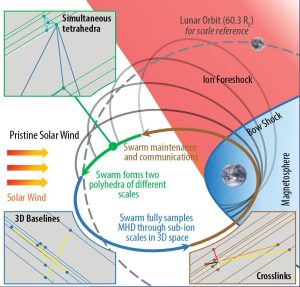Thematic group: PEPS
Scientific Leader: Vincent Génot
Main OSU: Observatoire Paris
Description / Background
The HelioSwarm mission concept, scheduled for launch in 2029, comprises a “mother” platform accompanied by 8 micro-satellites spaced between 50 and 3,000 km apart. The micro-satellites are equipped with a low-frequency magnetometer (FGM), a Faraday cup (FC) and a high-frequency search-coil magnetometer (SCM). The “mother” platform will also include an electrostatic analyzer (iESA) supplied by LAB and IRAP (resp. sci.: B. Lavraud, co-resp. sci.: V. Génot). The micro-satellites will communicate solely with the platform, which will receive their data and transmit them to the ground.

Scientific Objectives
HelioSwarm will explore the three-dimensional dynamical mechanisms that control the physics of plasma turbulence, a ubiquitous process in the heliosphere and in plasmas throughout the universe. To this end, simultaneous measurements will be made by the 9 satellites with separations covering magnetohydrodynamic and sub-ionic space scales in a variety of near-Earth plasmas (magnetosheath, shock and foreshock, solar wind). The 9 satellites make it possible to analyze correlations between measurements made by 36 different pairs, and to analyze 126 non-ideal tetrahedral configurations (compared with 6 pairs and 1 tetrahedron for 4-satellite missions).
Description of the SNO
The multi-point study of fundamental processes in space plasmas has been a high priority for the Solar-Terrestrial community for many years. Five French laboratories are directly involved in the HelioSwarm mission, including four with instrumental contributions. SNO-ANO2 HelioSwarm covers the tasks associated with the French instrumental contribution to the mission. The flight instruments will be delivered in 2026, while the engineering models are scheduled for delivery in 2025. The associated service tasks include monitoring the design, manufacture, testing, calibration and inter-calibration (SCM vs FGM and iESA vs FC) of these instruments on the ground and in flight, as well as the production, validation and archiving of L2 and L3 data at the CDPP. Responsibility for the SNO rotates over 2-year periods between the 4 Observatories involved.
IRAP implication
IRAP and LAB are in charge of supplying the electrostatic analyzer (iESA) for the rapid measurement of solar wind ions, in order to study in greater detail the relationship between ion heating and turbulence. The design of the iESA instrument relies heavily on PAS on board Solar Orbiter. IRAP is supplying the major part of the instrument, namely the electrostatic measurement head, the front-end board and the high-voltage board. The University of New Hampshire, MSSL and Aerospace Corp. will supply the digital (FPGA) and power (LVPS) boards.
Partnership
HelioSwarm is a NASA mission, with instrumental and scientific contributions from other national agencies, such as CNES for the iESA instrument and the SCMs (LPP, LPC2E), and the UK space agency for the FGM (Imperial College).

